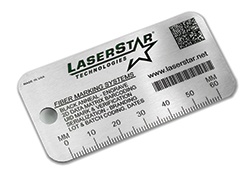Laser Systems for Direct Part Marking in Manufacturing
With the high number of manufactured parts used in most industrial applications, the need for parts identification has increased ten-fold over the past 30 to 50 years. This has given rise to the practice of direct part marking, which is the process of permanently marking parts to enable users to track them throughout their life cycle. The most common marks used to identify industrial parts are barcodes and data matrix codes, which are cut, engraved or stamped onto the parts. Laser marking technology is a popular method used for marking parts today.
2D Matrix Codes
A two-dimensional matrix code, also called a 2D Code, consists of black and white cells set up in a square or oblong shape. These symbols represent bits of data, with the black lines indicating a “1” and the white spaces indicating a “0” – the two digits used in data storage. The matrix can store up to 2,335 characters, including both letters and numbers, which are encoded onto the bits.
The codes are scalable, meaning that they can be etched onto metal in very small sizes such as 2 or 3 square millimetres with laser engraving equipment. This makes them the perfect option for direct part marking, such as their use in labeling small electronic components.
Readable Barcodes
Barcodes come in one- and two-dimensional options. The linear or one dimensional barcode represents data through the varied width and spacing of parallel lines. Two-dimensional barcodes use rectangles, dots, hexagons and other geometric patterns and symbols that are machine readable using computers, smart phones and barcode scanners. They are used in direct part marking mainly for the purpose of tracking data on manufactured components. The marks are laser engraved on the components for purposes such as:
- Lowering manufacturing costs through loss control
- Quality assurance
- Compliance with government regulations and industry standards
A Range of Uses
These methods of direct part marking are used in various applications. In industrial engineering, data matrix and barcodes are designed to last for the lifetime of the component, and this is a major reason for laser engraving them onto the parts. The marks are used to track movement of the components or conduct inventory stock checks.
The marks are also used in track and trace, anti-counterfeit operations and banking applications. Two-dimensional barcodes are used extensively in retail sales, while one-dimensional codes are used for purposes such as motor vehicle VIN numbers.
The Medical UID Program
The 2007 FDA Amendments Act established the Unique Device Identification (UID) system. Under this law, every device and its sub-components require labeling with a mark, which enables tracking of their lot and serial numbers through the medical community. The program's purpose is to address security and efficiency issues in the healthcare supply chain, reduce errors in medication, prevent counterfeiting and facilitate medical product recalls. A similar program is in use by the Department of Defense to enable traceability for all serially managed parts that are “sensitive and pilferable.”
Benefits of Using Laser Engraving
Benefits of laser-engraved direct part marking include:
- It’s not only permanent, it’s also very difficult to intentionally remove. This makes it ideal for identifying components that have a high value and need to be protected.
- Barcodes are easy to read using a range of systems, including mobile applications
- Laser engraving of marks enables very small sizes to be used with a high level of fidelity.
Direct part marking is a reliable method of identifying manufactured components and it’s here to stay. Laser engraving equipment works well to deliver high fidelity marks for most applications, depending on the material the parts are made from. Parts used in “safety critical” applications such as high pressure/stress systems and aircraft engineering require a non-intrusive method of direct part marking, which isn’t always as efficient as laser marking or engraving.
To learn more about direct part marking with laser marking technology, please contact LaserStar today or download our latest product catalog now!



